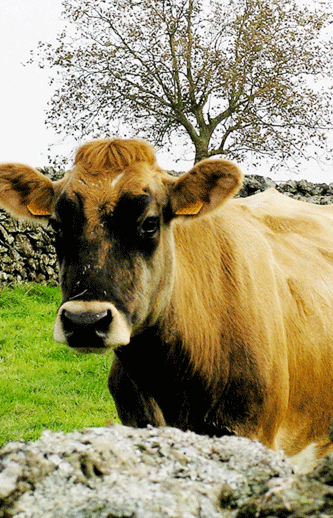 COUNTRY OF ORIGIN
COUNTRY OF ORIGINGrazing dairy cows, a model of sustainable agriculture
Presentation
The historian Gaspar Fructuoso, in his writings “Saudades da Terra”, written between 1586 and 1590, described Terceira, an island in the archipelago of the Azores, as: “An island with a infinite amount of cattle and sheep, a great number of domestic and wild pigs, and many goats, so that there is a great abundance of milk, butter, cream, cheese, cottage cheese and delicious cheese cakes.”
Four hundred years later, these words still ring true for anybody visiting the islands. This is a sure sign that the type of agriculture practised in the Azores, a region with a particularly fragile ecology, is compatible with the environment and animal welfare. This kind of agriculture can guarantee agricultural products at competitive prices, brings economic benefits to farmers and the local population, creates good prospects for rural families and also fosters the development of other important economic sectors, such as tourism and the service industry.
This type of dairy cattle farming model, which in industrialised countries is confined to marginal areas, though lately its distinctive qualities have been the subject of increasing interest, is typical of the Azores, the westernmost part of Europe. 
The model used in the Azores has specific characteristics: dairy cattle graze all year round; there are few barns or farm buildings to stock food, since the cows are always out at pasture; natural grazing is complemented by fodder and concentrate, the latter used to supplement pasture in times of bad weather or administered at the discretion of the breeder. Grazing is carried out on a rotation basis, which guarantees correct pasture management, limiting trampling and preventing the destruction of the vegetation layer. Fields are traditionally separated by stone walls, which also offer protection from winds and prevent the flowing of surface water. However, it was the introduction of electric fencing that led to a more functional management of grazing animals. This system of semi-intensive farming has produced significant results also terms of animal health.
Milking is carried out directly in the meadows thanks to the use of mobile milking machines, an innovation of the Azores. Pastureland can feed 2-2.5 cows/hectare, and good pastureland provides enough food for three cows per hectare; average production varies between 15 and 25 litres of milk per day, and costs are lower than in the rest of the European Community.
The Azores represent only 2.5% of the Portuguese territory but they provide almost 30% of Portugal’s total milk production.
This system of grazing cattle management is, in every respect, an advanced production model that can provide an excellent product at highly competitive prices. Since it is easy to set up and replicate, and requires little economic investment, this cattle grazing model can be easily applied, completely or in part, in any country that has dairy cattle.
DOWNLOAD THE BROCHURE PDF
English (0.8 MB)Spanish (0.8 MB)
Portuguese (0.8 MB)
ONLY TEXT
•Grazing dairy cattle in practice







